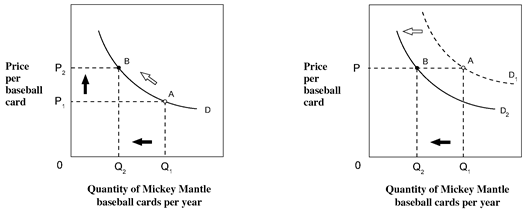 |
(a) Decrease in the quantity demanded (b) Decrease in demand
1.
Some people will pay a higher price for
brand-name goods. For example, some people buy Rolls-Royces and Rolex watches to
impress others. Does knowingly paying higher prices for certain items just to be
a “snob” violate the law of demand?
2.
Draw graph to illustrate the difference between a
decrease in the quantity demanded and a decrease in demand for Mickey Mantle
baseball cards. Give a possible reason for change in each graph.

(a) Decrease in the quantity demanded
(b) Decrease in demand
The decrease in the
quantity demanded is a response to an increase in the price from P1
to P2 per Mickey
Mantle baseball card. The decrease in demand from D1 to D2
is caused by a change in a nonprice determinant, such as a decrease in the
number of buyers.
3.
Suppose oil prices rise sharply for years as a
result of a war in the Persian Gulf region. What happens and why to demand for
a.
Cars?
b.
Home insulation?
c.
Coal?
d.
Tires?
Be sure you can graph these!!!!!
4. Predict the
direction of change for either supply or demand in the following situations:
a. Several new
companies enter the cell phone industry.
b. Consumers
suddenly decide that SUVs are unfashionable.
c. The U.S.
surgeon general issues a report stating that tomatoes prevent colds.
d. Frost
threatens to damage the coffee crop, and consumers expect the price to rise
sharply in the future.
e. The price of
tea falls. What is the effect on the coffee market?
f. The price of
sugar rises. What is the effect on the coffee market?
g. Tobacco
lobbyists convince Congress to remove the tax paid by sellers on each carton of
cigarettes sold.
h. A new type
of robot is invented that will pick peaches.
i. Ninendo
anticipates that the future price of its games will fall much lower than the
current price.
As always be sure you can graph these. I will provide the shifts here, but you will need to graph on the test.
(a)
Supply increases and price decreases.
(b)
Demand decreases and price decreases.
(c)
Demand increases and price increases.
(d)
Demand increases and price increases.
(e)
Demand decreases and price decreases.
(f)
Demand decreases and price decreases.
(g)
Supply increases and price decreases.
(h)
Supply increases and price decreases.
(I)
Supply increases and price decreases.
5. Explain the
effect of the following situations:
a. Population
growth surges rapidly.
b. The prices
of resources used in the production of good X increase.
c. The
government is paying a $1-per-unit subsidy for each unit of a good produced.
d. The incomes
of consumers of normal good X increase.
e. The incomes
of consumers of inferior good Y decrease.
f. Farmers are
deciding what crop to plant and learn that the price of corn has fallen relative
to the price of cotton.
a. demand shifts rights
b. supply shifts left
c. supply shifts right
d. supply shifts right
e. demand shifts right
f. supply shifts left
6. Explain why
the market price may not be the same as the equilibrium price.
The market price moves by trial and error
toward the equilibrium price. If the market price is above the equilibrium
price, there will be a surplus. If the market price is below the equilibrium
price, there will be a shortage.
7. If a new
breakthrough in manufacturing technology reduces the cost of producing DVD
players in half, what will happen to the
a. Supply of
DVD players?
b. demand for
DVD players?
c. equilibrium
price and quantity of DVD players?
d. demand for
DVDs?
a. supply increases
b. demand does not change
c. price falls and quantity increases
d. demand increases
8. There is a
shortage of college basketball and football tickets for some games, and a
surplus occurs for other games. What do shortages and surpluses exist for
different games?
Most of you recognized that the demand changes, but that will only cause a shortage or surplus if the price is fixed.